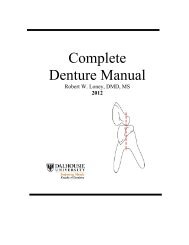RPD Manual 11 - Removable Prosthodontics - Dalhousie University
RPD Manual 11 - Removable Prosthodontics - Dalhousie University
RPD Manual 11 - Removable Prosthodontics - Dalhousie University
Create successful ePaper yourself
Turn your PDF publications into a flip-book with our unique Google optimized e-Paper software.
Surveying, Path of Insertion, Guiding Planes - 22<br />
Alteration of Other Axial Contours<br />
While guiding plane surfaces are the most common axial tooth preparations made for removable<br />
partial dentures, other axial preparations may also be required. These include:<br />
A. Lowering Height of Contours<br />
1. Lowering height of contours to eliminate tooth interferences in areas where rigid<br />
frameworks elements will be placed (such as rigid portions of retentive arms).<br />
2. Lowering height of contours to improve esthetics (e.g. to allow retentive arms to be<br />
placed more gingivally to reduce clasp display).<br />
When preparing axial contours for these situations, the heights of contour are most<br />
quickly lowered by placing the bur parallel to the path of insertion.<br />
B. Raising Height of Contours<br />
The only time that a height of contour would be raised would be when there is no retentive<br />
undercut present or when the undercut is so far gingival that the retentive tip would either<br />
impinge on the free gingival margin or cause a hygiene problem due to its proximity to the<br />
free gingival margin. In general, the inferior portion of the retentive undercut should be at<br />
least 1mm above the free gingival margin. Raising the height of contour is only feasible<br />
when the axial surface is parallel or slightly divergent to the path of insertion. If the<br />
surface is grossly divergent from the path of insertion, then raising the height of contour<br />
may be impossible.<br />
The tooth on the right is grossly<br />
divergent from the path of insertion,<br />
so that excessive preparation is<br />
required just to gain the appropriate<br />
undercut. Dentin, or in extreme<br />
cases, the pulp could be exposed.<br />
Minimal preparation will be required<br />
on the tooth on the left since its long<br />
axis is close to the path of insertion.<br />
Raising the height of contour for retentive undercuts can be accomplished by:<br />
1. Preparing a retentive undercut. Prepare an ovoid undercut with the inferior border at<br />
least 1 mm from the free gingival margin, using a round or chamfer diamond bur.<br />
Correct Should be more Too close to<br />
ovoid, like clasp free gingival<br />
tip margin















